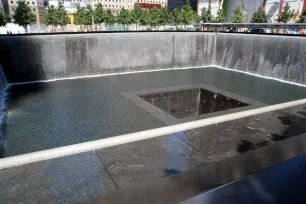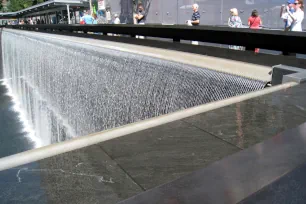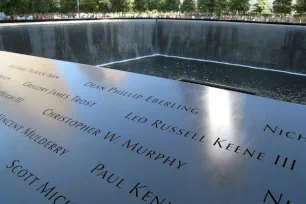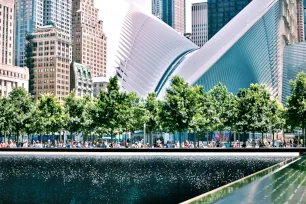The National September 11 Memorial commemorates the victims of the terrorist attacks on the World Trade Center. The memorial opened on the tenth anniversary of the attacks at the site of the former twin towers of the WTC.
Design Competition


Soon after the attacks on the World Trade Center, plans were made to create a memorial to commemorate the victims of the tragedy. As early as in April 2003, a competition was launched by the Lower Manhattan Development Corporation for the design of a World Trade Center memorial. In total, 5,201 submissions were made from 63 different countries.
On January 6, 2004, a 13-member jury selected a design by architects Michael Arad and Peter Walker. The jury lauded the openness of the design, which was dubbed ‘Reflecting Absence’.
Reflecting Absence
The winning design was unveiled to the public on January 14, 2004. It consists of a 6-acre (2,5 ha.) memorial plaza with a grove of 124 white oak trees and two large illuminated reflecting pools. The pools, which mark the exact site of the former twin towers, are recessed, and its walls form a series of cascading waterfalls. The names of the 2,977 people who died on September 11 (including those who died in similar attacks in Pennsylvania and Washington, DC) as well as the victims of the 1993 WTC bombing are inscribed around the edge of the waterfalls. The memorial was inaugurated on September 11, 2011, exactly ten years after the terrorist attack, and opened to the public the following day.


The memorial is now officially known as the 9/11 memorial, referring to the date of the terrorist attacks, which occurred on the 11th of September 2001 (The American date format shows the month first, followed by the day). The memorial plaza is built on top of a large transit hub completed in 2016. The hub is marked by a spectacular PATH entrance station known as the Oculus, created by the celebrated Spanish architect Santiago Calatrava. The Oculus forms a spectacular backdrop to the memorial.
Memorial Museum
An underground museum opened to the public on May 21, 2014. The museum is at the level of the bedrock (the solid rock foundation on which the World Trade Center rested), seven stories below the Memorial. It was designed by the architectural firm DBB. The museum is entered through a glass pavilion created by Snøhetta, an international design firm best known for its design of the opera house in Oslo, Norway. Multimedia displays and artifacts from the Twin Towers spread around 110,000 sq. ft. (10,000 sq.m.) of exhibition space tell the story of the attack and its impact.
Survivor Tree
One of the many trees planted at the memorial site is known as the «Survivor Tree». The tree, a Callery pear, was recovered from the rubble of the WTC in October 2001. Originally planted in the 1970s, the tree was badly damaged and burned, but still had a living branch. It was nursed by the N.Y.C. Parks Department and recovered. In December 2010, the tree was replanted at the memorial plaza.
- Next: Fifth Avenue
- More Sights & Attractions in New York

